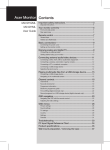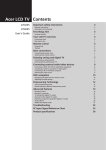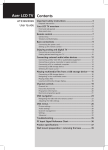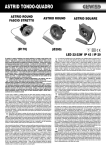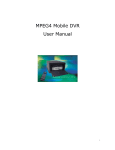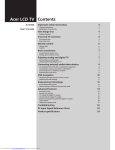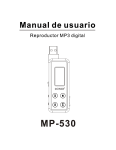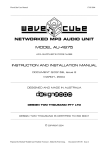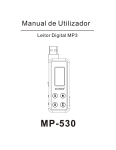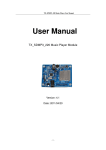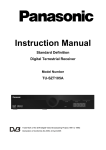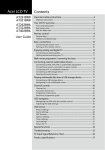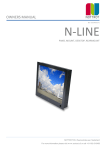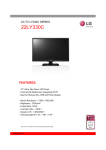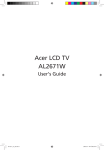Download Acer AT4258ML Owner's Manual
Transcript
Acer LCD TV Contents AT4258ML AT4285MLX User Guide Important safety instructions-------------------------------------- 3 Disposal instructions-----------------------------------------------------------------------4 Your LCD TV overview------------------------------------------------ 5 Front and side panels---------------------------------------------------------------------5 Rear panel view-----------------------------------------------------------------------------6 Remote control---------------------------------------------------------- 7 General keys---------------------------------------------------------------------------------7 Teletext and Multimedia-----------------------------------------------------------------8 Basic connections------------------------------------------------------- 9 Connecting the power cord-------------------------------------------------------------9 Setting up the remote control---------------------------------------------------------9 Enjoying analog and digital TV------------------------------------ 9 Connecting an antenna/cable----------------------------------------------------------9 Getting started watching your TV-------------------------------------------------- 10 Connecting external audio/video devices-------------------- 11 Connecting a DVD, VCR, STB or audio/video equipment-------------------- 11 Connecting a camera, camcorder or game console--------------------------- 12 Connecting a PC or notebook computer------------------------------------------ 13 Connecting a USB storage device--------------------------------------------------- 13 Selecting the input source------------------------------------------------------------- 14 Playing multimedia files from a USB storage device------ 15 Connecting a USB storage device--------------------------------------------------- 15 Navigating in the multimedia screen---------------------------------------------- 15 Channel controls------------------------------------------------------ 18 Channel list--------------------------------------------------------------------------------- 18 Favourite channel list------------------------------------------------------------------- 19 Programme information--------------------------------------------------------------- 20 Electronic programme guide--------------------------------------------------------- 20 Time shifting (digital channels only)----------------------------------------------- 22 Record programs to a USB storage device (digital channels only)-------- 22 OSD navigation------------------------------------------------------- 23 Navigating the OSD with the remote control----------------------------------- 23 Adjusting the OSD settings------------------------------------------------------------ 24 OSD menus------------------------------------------------------------- 26 Picture settings---------------------------------------------------------------------------- 26 Sound settings----------------------------------------------------------------------------- 28 TV settings---------------------------------------------------------------------------------- 29 Country-------------------------------------------------------------------------------------- 29 Settings-------------------------------------------------------------------------------------- 30 Parental------------------------------------------------------------------------------------- 31 Troubleshooting------------------------------------------------------ 33 PC Input Signal Reference Chart--------------------------------- 34 Product specifications----------------------------------------------- 35 Wall mount preparation / removing the base-------------- 37 1 © 2010 All Rights Reserved. Acer LCD TV User Guide Original Issue: 08/2010 Model Number: Serial Number: Purchase Date: Place of Purchase: HDMI, the HDMI logo and High-Definition Multimedia Interface are trademarks or registered trademarks of HDMI Licensing LLC. DVB is a registered trademark of the DVB Project. 2 Important safety instructions Read these instructions carefully. Please put them somewhere safe for future reference. 1. Only use attachments/accessories specified by the manufacturer. 3. Unplug this apparatus during lightning storms or when unused for long periods of time. 4. Do not install this equipment in a confined space such a book case or similar unit. 5. No naked flame sources, such as lighted candles, should be placed on the apparatus. 6. If the remote control will not to be used for a long time, remove the batteries. Use the remote control carefully. Do not drop the remote control on the floor. Keep it away from moisture, direct sunlight, and high temperatures. 7. Used or discharged batteries must be properly disposed of or recycled in compliance with all applicable laws. For detailed information, contact your local solid waste disposal authority. 8 Follow all warnings and instructions marked on the product. 9 Unplug this product from the wall outlet before cleaning. Do not use liquid cleaners or aerosol cleaners. Use a damp cloth for cleaning. 10 Do not use this product near water. 11 Do not place this product on an unstable cart, stand or table. The product may fall, sustaining serious damage. 12 Slots and openings are provided for ventilation; to ensure reliable operation of the product and to protect it from overheating, these openings must not be blocked or covered. The openings should never be blocked by placing the product on a bed, sofa, rug or other similar surface. This product should never be placed near or over a radiator or heat register or in a built-in installation unless proper ventilation is provided. 13 This product should be operated from the type of power indicated on the marking label. If you are not sure of the type of power available, consult your dealer or local power company. 14 Do not allow anything to rest on the power cord. Do not locate this product where the cord will be stepped on. 15 If an extension cord is used with this product, make sure that the total ampere rating of the equipment plugged into the extension cord does not exceed the extension cord ampere rating. Also, make sure that the total rating of all products plugged into the wall outlet does not exceed the fuse rating. 16 Never push objects of any kind into this product through cabinet slots as they may touch dangerous voltage points or short-out parts, which could result in a fire or electric shock. Never spill liquid of any kind on the product. 17 Do not attempt to service this product yourself, as opening or removing covers may expose you to dangerous voltage points or other risks. Refer all servicing to qualified service personnel. 18 Unplug this product from the wall outlet and refer servicing to qualified service personnel under the following conditions: English 2. Use only with the cart, stand, tripod, bracket, or table specified by the manufacturer, or sold with the apparatus. When a cart is used, use caution when moving the cart/ apparatus combination to avoid injury from tip-over. a.When the power cord or plug is damaged or frayed. b.If liquid has been spilled into the product. c. If the product has been exposed to rain or water. English d.If the product does not operate normally when the operating instructions are followed. Adjust only those controls that are covered by the operating instructions. Improper adjustment of other controls could result in damage; extensive work by a qualified technician might then be required to restore the product to normal condition. e.If the product has been dropped or the case has been damaged. f. If the product exhibits a distinct change in performance, indicating a need for service. 19 Use only the proper type of power supply cord set (provided in your accessories box) for this unit. Always disconnect the power cord from the wall outlet before servicing or disassembling this equipment. 20 Do not overload an electrical AC outlet, power strip, or convenience receptical. The overall system load must not exceed 80% of the branch circuit rating. If power strips are used, the load should not exceed 80% of the power strip input rating. 21 Some products are equipped with a three-wire electrical grounding-type plug that has a third pin for grounding. This plug only fits into a grounded electrical outlet. This is a safety feature. Make sure the AC outlet is properly grounded. Do not defeat the safety purpose of the grounding-type plug by trying to insert it into a nongrounded outlet. If you cannot insert the plug into the outlet, contact your electrician to replace the obsolete outlet. 22 Do not use this LCD TV in the workplace in accordance with BildscharbV, and maintain ample distance from it when watching. Watching a big-screen TV too close can cause eyestrain. 23 This TV is designed for home entertainment purposes only. Make sure there is sufficient distance between you and the TV when you are viewing content to avoid harming your eyes. The grounding pin is an important safety feature. It is possible to receive an electric shock from a system that is not properly grounded. The grounding pin is also providing good immunity ability against unexpected noise that interferes performance of this product and is produced by other nearby electrical devices. Disposal instructions Do not throw this electronic device into the rubbish bin / container when discarding. To minimize pollution and ensure utmost protection of the global environment, please recycle. For more information regarding WEEE, please refer to http://global.acer.com/about/environmental.htm Соответствует сертификатам, обязательным в РФ (Compliant with Russian regulatory certification) 4 Your LCD TV overview 1 Common interface 2 Tuner (hybrid) 3 USB port 4 VGA-in + PC Audio-in 5 Earphone 6 HDMI port English Front and side panels 1 2 3 4 5 6 7 8 9 10 11 12 13 7 Volume down When the OSD is on, functions the same as the Left arrow. 8 Volume up When the OSD is on, functions the same as the Right arrow. 9 Channel down When the OSD is on, functions the same as the Down arrow. 10 Channel up When the OSD is on, functions the same as the Up arrow. 11 Menu key Turns the OSD menu ON and OFF. 12 Source (Input) key Press to change input source. When the OSD is on, press this button to confirm selection. 13 Power button The control buttons are touch-sensitive. Simply touch the area to activate the function. 5 English Rear panel view 1 DC-in 2 AV in-COMPONENT + Audio L/R 3 SCART/CVBS Video+Audio port 4 SPDIF out 5 HDMI port 1 6 2 3 4 5 Remote control General keys 1 2 3 6 SUBTITLE Press to view subtitles on the screen. 4 7 VOL (+/-) Press to increase or decrease the volume. 5 8 CH (up/down) Press to sequentially select the TV channel. 6 English 5 TELETEXT/MIX Press to switch from TV/AV to Teletext mode. Press again to overlay teletext page on the TV image. 9 MUTE Press to toggle audio on and off. 7 8 10 MENU Press to open or close the Menu. 10 9 11 11 BACK Press to back to previous Menu. 12 13 14 15 16 17 1 POWER Press to turn your TV on/off. 2 SOURCE (TV/YPbPr/AV/SCART/PC/HDMI/USB) Press to select correct input mode. 3 DISPLAY Press to display or change input/ channel information (dependent on input/source type). 4 Number keys. 12 Directional keys On certain models, the left and right directional keys also function as rewind and fast-forward keys when viewing multimedia files. 13 OK/ENTER/CH LIST ENTER: Press to confirm channel number selection. CH LIST: Press to launch the channel list. See page 33. 14 GUIDE Press to launch Electronic Programme Guide (EPG) mode (Digital TV mode only). See page 34. 15 FAV Press to display the favorite channel list. 16 WIDE Press to toggle scaling mode between Auto, Normal, Zoom1, Zoom2 and Wide modes. 17 MPX Press to display and select the audio signal. 7 Teletext and Multimedia English 1 2 5 3 4 Teletext Multimedia 1 Colour buttons (R/G/Y/B) Operates corresponding button on the teletext page. 1 Colour buttons (R/G/Y/B) No function when using the mutimedia interface. 2 INDEX Press to go to the index page. 2 Previous Track Press to go to the beginning of a track, or the previous track. 3 SIZE Press once to zoom teletext page to 2X. Press again to resume. 4 HOLD Press to pause the current teletext page. 5 REVEAL Press to reveal hidden teletext information. 3 Stop Press to stop playback. On certain televisions the remote control can start recording programmes. This feature is not available on your television. 4 Play/Pause Press to start playing the selected track, or pause a track if it is already playing. 5 Next track Press to skip to the next track if multiple tracks have been selected. 6 You may use the left and right directional buttons to avance or rewind in a track. Press the button again to increase how fast the track advances (x2/x4/x8/x16). Press the Play/Pause button to resume playback. 8 The left and right directional keys also function as rewind and fast-forward keys when viewing multimedia files. Basic connections Connecting the power cord English 1 Connect the AC cord into the AC input on the back of the set. 2 Connect the plug to the wall outlet as shown. Setting up the remote control 1 Open the cover on the bottom of the remote unit. 2 Insert two AA batteries (supplied) to match the polarity indicated inside the battery compartment. Enjoying analog and digital TV Connecting an antenna/cable Connect the antenna cable to the appropriate antenna terminal on the back of the TV set as shown below. Tuner 9 Getting started watching your TV English 1 4 3 2 1 1 1 Power a. Turn on the power switch. b. Press the power button or channel up/down button on the remote control. 2 Installation Guide The first time you switch on the TV, you will be asked to select the language and scan for channels. Press the OK key to begin the setup process. You can also adjust these settings using the front control panel. Please see "Front panel view" on page 8 for details. Step 1. Step 2. Step 3. Step 4. Step 5. Step 6. Select the setup language you prefer. Please select the correct country for signal reception. Select Home mode. Ensure that your co-axial cables are connected correctly before proceeding. Scan for digital channels and analog channels. Setup is now complete. You are ready to begin watching TV. 3 Changing channels a. Press 0 - 9 on the remote control to select a channel. The channel changes after 2 seconds. Press OK to select the channel immediately. b. Pressing the channel ( CH ) up / down button on the remote control will also change the channel. 4 Adjusting the volume Adjust the volume level using the ( VOL ) up/down button on the remote control. Setup may vary due to local broadcast differences. 10 Connecting external audio/video devices English Connecting a DVD, VCR, STB or audio/video equipment Connect your DVD player, VCR or audio/video equipment using the SCART port located at the rear of your LCD TV as shown below. Source-in D-Sub G B R W R HDMI COMPONENT HDMI COMPOSITE Y Yellow R Red W White B Blue G Green AV PC-Audio in HDMI SCART AUDIO Y VGA W R Y W R D-Sub G B R W R Y W R or DVD or VCR STB PC * Acer recommends the following priority for connection types: HDMI -> COMPONENT -> SCART -> Composite. 11 English TV-out SPDIF Recorder AV Connecting a camera, camcorder or game console Connect your camera or camcorder to the video/audio ports on the left of the TV set as shown below. G B R W R COMPONENT COMPOSITE SCART AUDIO Y AV G 12 B W R Y W R W R Y R W R HDMI HDMI HDMI Connecting a PC or notebook computer To display PC output on your TV, connect your PC or notebook computer to the TV as shown below. English D-Sub D-Sub For VGA connections, Acer recommends setting your PC’s external monitor resolution to 1920 x 1080 pixels @ 60 Hz refresh rate. Connecting a USB storage device To display multimedia content on your TV, connect the USB device to the TV as shown below. Handy drive 13 Selecting the input source Once you have connected your antenna or external equipment to the TV, you need to select the correct input source. English Press the SOURCE button on the remote control to select the correct input source (TV/YPbPr/AV/SCART/PC/HDMI/USB). 14 Playing multimedia files from a USB storage device English Connecting a USB storage device Connect the USB storage device to the USB port on your computer. Press the Source button on the remote control and select USB. Navigating in the multimedia screen There are three main areas of the multimedia screen: a b c a. Status bar The top of the screen shows the type of media being viewed: Photo, Music or Movie, with some information about the selected file. Press the MENU button and select Media Type to change the type of media being shown: Select Photo, Music or Video and press the OK button. 15 b. Navigation menu The middle of the screen shows the contents of the USB device. Use the directional keys and press OK to open a file or folder. English Note: Only files that match the selected media type are displayed. Press the BACK button to return to the folder that contains the folder being viewed. c. File option bar The bottom of the screen shows addition options for the file being viewed, such as volume level or special functions for the coloured buttons on the remote control. Note: When playing a movie or viewing photos, the top and bottom bars will disappear after a short delay. Photo files Select a photo and press OK to open it. Photo files will be shown in a slideshow, each photo will be displayed for a short duration. Press Play/Pause to pause the display on a specific photo. Press Previous (‘Index’) or Next (‘Reveal’) to return to the previous photo, or to view the next photo. Press BACK or return to the folder navigation list Music files Select a music file and press OK to open it. Press Play/Pause to pause a track. Press Previous (‘Index’) or Next (‘Reveal’) to skip to the previous track or advance to the next track in the folder. Press and hold the left and right directional buttons to advance or rewind in a track. Press BACK to return to the folder navigation list and preview screen. 16 Movie files Select a movie file and press OK to open it. Press Play/Pause to pause a movie. English Press Previous (‘Index’) or Next (‘Reveal’) to skip to the previous movie or advance to the next movie in the folder. You may use the left and right directional buttons to advance or rewind in a movie. Press the button again to increase how fast the track advances or rewinds (x2/x4/x8/x16). Press BACK to return to the folder navigation list and preview screen. Leaving multimedia storage display Simply stop playback and press Source to select a different source type. Warning: Do not remove the USB storage device while a media file is playing. Stop playback and switch to a different source before removing the device from the USB port. 17 Channel controls English Channel list Channel list allows you to quickly find the TV channel you are searching for. To open the channel list feature: 1 Press the OK key on the remote control. This will bring up the channel list menu. 2 The current channel will be highlighted. Use the directional keys to navigate the list and select the channel you wish to watch. 3 Use the red key to switch between the digital and analogue channel lists. Use the green key to exit the list. 18 Favourite channel list The favourite channel list allows you to store your favourite TV channels and flick between them at the touch of a button. To set a favourite channel, follow the steps described on this page. English Storing favourite channels 1 Press the FAV key on the remote control. This will bring up the favourite channel list. 2 The Favourite list will be shown. Press OK to select, delete or add a favourite channel. 3 Press the BACK key on the remote control to exit. Viewing your favourite channels On the remote control, if you press the FAV key, the TV will display a list of favourite TV channels. Use the up or down directional keys to select a channel, and then press OK. 19 Programme information Press the DISPLAY key to see information about the current programme (if available). English a b c d e a. Programme title b. Programme schedule c. Subtitle If ‘Subtitle’ is displayed press the SUBTITLE key to see a list of available subtitles. d. Audio language e. Programme summary Electronic programme guide The electronic programme guide (EPG) is an onscreen service available on digital and cable TV that provides information about scheduled broadcast programmes on all digital channels by time, title and channel. 20 Guide screen There are four main areas of the EPG screen: a English c b d The top of the screen shows the type of signal being viewed and the current time; with the channel number, channel title and selected program name on the right. The section on the left shows all names for digital channels. The section on the right shows information about programs for the selected channel: the start and finish times, any age rating and a summary. Use the up or down directional keys to switch to the previous or next channel. Navigating the EPG (for Digital TV mode) 1 Press the GUIDE key on the remote control. 2 Use the directional keys to navigate around the EPG menu and press OK to select your highlighted option. 21 Time shifting (digital channels only) English Your TV allows you to temporarily store (‘time shift’) a program to a USB storage device (digital channels only); this allows you to pause the program, and later resume playback from that point. Step 1. Connect a USB storage device to the USB port on your TV. Step 2. While viewing a digital TV channel, press PAUSE to start the time shift function. If the USB storage device has not been configured for use with your TV, select Auto in the window that is displayed. Step 3. Use left and right direction keys to rewind and fast-forward the time-shifted program. Step 4. Press BACK to disable time shifting. Note: The USB storage device must have at least one gigabyte (GB) of free space to store time shifting information. It is recommended you use an empty USB device. If a Sleep timer had been set before activating the time shift function, the timer will be suspended. Warning: Do not remove the USB storage device while time shifting is active. Disable time shifting before removing the device from the USB port. Note: 180 minutes of 480i content, or 30 minutes of 1080i content, requires approximately four gigabytes (GB) of memory. The time shift function cannot store more than four gigabytes of time shift information. Once four gigabytes of data has been stored, the time shift function will delete the stored data and restart storing content. This occurs even if more storage is available. Record programs to a USB storage device (digital channels only) Your TV allows you to record digital TV programs to a USB storage device. Step 1. Connect a USB storage device to the USB port on your TV. Step 2. While viewing a digital TV channel, press STOP/REC to start recording the program. A confirmation message will be displayed for a short duration. Step 3. A progress indicator in the lower-left corner of the screen shows the duration of the recording. Step 4. Press STOP/REC again to stop recording the program. Step 5. Use the multimedia player to view your recorded programs (see“ Playing multimedia files from a USB storage device“ ). Recorded files are stored in the“ PVR“ folder. Warning: Some USB storage devices may not support to the time shifting or recording functions. Please use a different storage device. 22 OSD navigation Many of the advanced settings and adjustments are available through using the OSD (onscreen display) menus, as shown in the example screenshot below. English Basic operations required to navigate these menus (Picture, Audio, Channel management, Settings and Advanced) are described in this section. Navigating the OSD with the remote control You can also interact with these menus using the right panel controls. Please see "Front panel view" on page 5 for details. There are five main OSD menus. These are: Picture, Audio, Channel management, Settings and Advanced. Use the following method to navigate these menus. 1 Press the MENU button on the remote control or the MENU button on the control panel. Select your desired menu by using the up and down directional keys to switch between the five menus. 2 Press OK or the right directional key to enter a menu. Press BACK or the left directional key to return to the menus. 3 Use the directional keys to interact with the menu. The up / down directions will scroll through the menu options, while left/right will adjust the different settings (for example, in the Picture menu, settings such as brightness, contrast, etc.). Press MENU to exit. 23 Adjusting the OSD settings The OSD can be used for adjusting the settings of your LCD TV. English Press the Menu key to open the OSD. You can use the OSD to adjust the picture quality, audio settings, channel settings and general settings. For advanced settings, please refer to following page: Adjusting picture quality 1 Press the Menu key to bring up the OSD. 2 Using the directional keys, select Picture from the OSD. Then navigate to the picture element you wish to adjust. 3 Use the left or right keys to adjust the sliding scales or select one of the preset scenario modes. Press MENU to save and exit. 4 The Picture menu can be used to adjust the current Scenario Mode, Brightness, Contrast, Colour, Tint, Sharpness and other image-related qualities. Adjusting sound settings 1 Press the Menu key to bring up the OSD. 2 Using the directional keys, select Sound from the onscreen display. Then navigate to the feature you wish to adjust. 3 Use the left or right keys to adjust the sliding scales or select one of the preset scenario modes. Press MENU to save and exit. 4 The Sound menu can also be used to adjust the the current Sound Mode, Equaliter, Steady Sound, Sound Effects and other important sound-related settings. Adjusting TV settings 1 Press the Menu key to bring up the OSD. 2 Using the directional keys, select TV from the OSD. 3 Use the directional keys to navigate the menus. 4 The TV menu can be used to adjust Tuner mode, Country, Channels, Channel Edit and other important channel-related settings. 24 Adjusting settings 1 Press the Menu key to bring up the OSD. 2 Using the directional keys, select Settings from the OSD. Then navigate to the feature you wish to adjust. English 3 The Settings menu can be used to adjust the screen Menu Language, Time, Subtitle, Teletext and other important settings. Adjusting Parental settings 1 Press the Menu key to bring up the OSD. 2 Using the directional keys, select Parental from the OSD. Then navigate to the feature you wish to adjust. 3 The Parental menu can be used to adjust the Channel block, Parental guidance, Input block, Change password and other important settings. The options available on the OSD may vary depending on the TV signal source and model. Some digital options may not be available with an analog signal and vice versa. 25 OSD menus English Picture settings Open the Picture menu as described in the OSD navigation section. This menu provides the following settings: Scenario mode Scenario mode provides preset viewing modes designed to give you the best picture quality when watching a particular kind of programme. These provide preset values for brightness, contrast, hue colour and sharpness. There are pre-defined audio and video settings for optimal enjoyment of the following scenarios: Standard, Movie, Game, Sport, Concert, User. 26 Mode Information Standard Standard mode allows you to watch your favourite channels with sharp, brilliant imagery via adaptive brightness and contrast adjustments. Movie For comfortably enjoying movies at home, Movie mode displays dim scenes in clear detail; compensates for colour; and smoothly presents motion images. This is accomplished through optimal Gamma correction plus saturation, brightness and contrast adjustments. Sport Sport mode is suited for outdoor sports programmes, with accurate background depth and clear gradation between the bright, outdoor playing field and darker auditoriums. Sports mode also brilliantly enhances colours and presents swiftly moving pictures without residual images. All of this is achieved via specific Gamma corrections and saturation adjustments. Concert Concert mode places you in a virtual concert hall, opera house or other dim environment by means of adaptive brightness and contrast adjustments. Game Game mode carefully details the exquisite graphics of modern video games, providing lifelike entertainment while protecting your eyesight by adjusting brightness and contrast. User User mode allows you to save your favourite video settings. Brightness Change the brightness of the image. Contrast English Change the contrast of the image. Colour Change the colour depth of the image. Tint Change the tint of the image. Sharpness Change the sharpness of the image. Colour temperature This setting adjusts the colour temperature of the image. You can set it to Standard, Cold, User or Warm depending on your preference. With the User setting, you may change the colour values individually. Advanced Noise reduction Reduce any noise on the video signal Flesh tone Enhanced flesh tones in the video Backlight Change the brightness of the TV backlight ACM Activates Automatic Contrast Management to adjust the backlight brightness depending on the video 27 Sound settings Open the Audio menu as described in the OSD navigation section. This menu provides the following settings: English Sound mode Scenario mode provides preset audio modes designed to give you the best sound quality when listening to a particular kind of programme. These provide preset values for treble and bass. There are pre-defined audio and video settings for optimal enjoyment of the following scenarios: Music, Speech, User. For example, Music mode accentuates symphonic harmonies and the tenor audio range. Equalizer 120 Hz / 500 Hz / 1.5 KHz / 5 KHz / 10 KHz Adjust the volume for certain frequency bands Balance Change the balance between the left and right speakers. Sound effect Turn Sound Effects on to add virtual surround sound. If Sound Effects are on, Treble and Bass settings are not available. Digital Audio Out This allows you to set the type of Digital audio signal that is used. Steady sound This function prevents sudden changes in the audio output level. If this function is On, volume levels will be consistent when switching between input sources and changing channels. Audio type Access audio options for the hard of hearing or visually impaired. Audio description Adjust the volume for the spoken menu description for the visually impaired. 28 TV settings Open the TV menu as described in the OSD navigation section. This menu provides the following settings: English Tuner mode Adjust the signal settings to receive Antenna or Cable signals. Country Select the country you live in to scan for the correct signals. Channels Channel scan Channel scan allows you to scan for channels. If you completed the setup wizard the first time you turned on your TV, all available channels are listed. Wait until the scan has finished; this will take several minutes. Update scan Update scan allows you to scan for new or deleted channels. Wait until the scan has finished; this will take several minutes. Single RF scan You can manually add a digital channel by searching in specific UHF channels. Analogue manual scan You can manually add an analog channel by adjusting the settings here. Channel edit You can edit the detected channels, to change how they are displayed in the channel list. Use the up or down directional keys to select a channel, direction, OK and number keys to change the channel number or name. Intelligent zapping If Intelligent Zapping is on, then channels viewed for less than the period defined here will not be added to the zapping memory. 29 Settings Open the Settings menu as described in the OSD navigation section. This menu provides the following settings: English Menu language Set the language displayed for the OSD menus. Wide mode Press to toggle scaling mode between Normal, Wide and different zoom modes (1, 2). Auto is also available when viewing digital TV and HDMI signals. Time Use these settings to adjust the time and set the sleep delay. Time zone Set your time zone. Time Set the time and date. Sleep You can set a time delay, after which the TV will turn off. The delay can be 15, 30, 45, 60, 90 or 120 minutes. Subtitle Use these settings to adjust subtitles. Analogue subtitles Set if subtitles are displayed when available. 1st / 2nd subtitle Set the 1st and 2nd priority for subtitle languages, if more than one subtitle is available. Subtitle type You can choose between normal subtitles and subtitles for the hearing impaired, when these are available. Teletext language Use these settings to adjust digital teletext settings. Digital Teletext language Set the language used for digital teletext pages. Decode page language Set the type of text used for teletext pages. Common interface Displays information about any card installed in the common interface slot. Reset default Return all settings to default values, removing any changes. 30 Automatic power off If Automatic Power Off is active, if the TV on for four hours without any channel changes or other activity, it will turn off. A warning message is displayed before the TV turns off. On screen help English Show onscreen help messages. Parental Open the Parental menu as described in the OSD navigation section. Enter your Password (see below), then select one of the three options. Parental control allows you to enter a password and effectively stop anyone without the password from watching TV. Three options are available: Channel Block, Age Rating and Change Password. This menu provides the following settings: Channel block Press OK to see the list of channels. Use the up and down directional keys to select the channel to block and then press OK. A padlock symbol is displayed next to blocked channels. Press the OK again to unblock a channel. When viewing channels, if a blocked channel is selected the TV will ask for your password. Enter your password to view the channel. Parental Guidance Most digital TV allows you to block content according to rating systems. The rating system used is dependent on region, and is only available on digital channels. Analog channels will not be blocked with this option. Age rating (for digital TV) The settings cover from 4 to 18 years of age. When you lock a category, the categories for that age and younger will be blocked. 31 Input block Press OK to see the list of input sources (SCART, HDMI, etc.). Use the up and down directional keys to select the input source to block and then press OK. A padlock symbol is displayed next to blocked input sources. Press the OK again to unblock an input source. English Set password You can change the default password to a 4-digit code of your choice. If you are using the parental controls, then we recommend you change the password periodically. Clear all Return all parental settings to default values, removing any changes. The default password for this TV is “0000.” If you forget your password, please enter 6163 to reset. 32 Troubleshooting Before you call the Acer service center, please check the following items: English Here is a list of possible situations that may arise during the use of your LCD TV. Easy answers and solutions are provided for each. There is no picture or sound • Make sure the power cord is properly inserted in the power outlet. • Make sure the input mode is correctly set by your selected input. • Make sure the antenna at the rear of the TV is properly connected. • Make sure the main power switch is turned on. • Make sure the volume is not set to minimum or the sound is not set to mute. • Make sure the headphones are not connected. • Reception other than those of broadcasting stations can be considered. Picture is not clear • Make sure the antenna cable is properly connected. • Consider whether your TV signal is being properly received. • Poor picture quality can occur due to a VHS camera, camcorder, or other peripheral being connected at the same time. Switch off one of the other peripherals. • The 'ghost' or double image may be caused by obstruction to the antenna due to high-rise buildings or hills. Using a highly directional antenna may improve the picture quality. • The horizontal dotted lines shown on the pictures may be caused by electrical interference, e.g., hair dryer, nearby neon lights, etc. Turn off or remove these. Picture is too dark, too light or tinted • Check the colour adjustment. • Check the brightness setting. • Check the sharpness function. • The fluorescent lamp may have reached the end of its service life. Remote control does not work • Check the batteries of the remote control. • Make sure the remote sensor window is not under strong fluorescent lighting. • Try to clean the remote control sensor lens on the TV with a soft cloth. • Use the buttons (hotkeys) on the TV before the remote control works. If the above suggestions do not solve your technical issue, please refer to the warranty card for service information. 33 PC Input Signal Reference Chart English Item H.Freq. (KHz) Mode Resolution V.Freq. (Hz) 1 31.469 IBM VGA 12H 640x480 59.94 2 35.156 VESA 800x600 56.25 3 37.879 VESA 800x600 60.317 4 48.363 VESA 1024x768 60.004 5 44.772 HD 1280x720 59.855 6 44.776 CVT 2.3MA 1280x768 60 7 47.712 VESA 1360x768 60 8 63.981 VESA 1280x1024 60 9 66.587 FHD 1920x1080 60 PC input does not support Sync on Green, Composite Sync or interlaced signals. 34 Product specifications Brightness (typ.) Contrast Ratio (typ.) Dynamic Contrast Ratio (max.) Viewing angle (typ.) Response (typ.) True motion Power supply Input Max. power consumption Power saving Mechanical Dimensions (W x H x D mm) Weight (kg) Weight (lbs.) Wall-mounting holes Analog TV system Colour system Sound system Stereo system Subtitle Digital TV system Digital TV standard Sound system Stereo system AT4258ML AT4285MLX 1920 x 1080 1920 x 1080 400 nit English Model Panel spec Resolution (pixels) 450 nit 4000:1 InfiniteCons 178x178(CR>=10) 6.5 ms (Gray to Gray) -- 100 Hz 220VAC, 50/60 Hz 165 W <1 W 1019.07 x 211 x 669.5 1041.2 x 242.2 x 688 22.86 24.8 58.06 62.992 VESA, 200 mm x 200 mm PAL, SECAM B/G/D/K/I/L NICAM/A2 Teletext 1.5 (1000 pages) DVB-T HD (H.264)/DVB-C ISO11172-3 layer 1 & layer 2 ISO14496-3 HE-AAC 32KHz,44.1KHz,48KHz PCM/MPEG ( Layer I & II ), HE-AAC Dolby AC-3/AC-3 + 35 English Frequency Model Terminal Analog/Digital Tuner In SCART Component in AV-in HDMI 1 HDMI 2 PC D-sub in PC audio in SPDIF out Headphone out USB Port Resolution HDMI Audio system Speakers Mutimedia support via USB Photo Audio Video 36 7/8 MHz AT4258ML AT4285MLX Hybrid CVBS (In/Out), RGB (In), Audio R/L YPbPr, Audio (R/L) CVBS, Audio (R/L) Yes (HDMI 1.3) Yes (HDMI 1.3) Yes Yes Yes (Coxial) Yes Yes 480i/p, 576i/p, 720p, 1080i, 1080p 10 W + 10 W JPG, BMP, PNG MP3, AAC MPEG-2, H.264 Wall mount preparation / removing the base English Caution: Disassemble the base carefully otherwise the plastic parts and/or TV body may be damaged. 1) Remove the base. 2) Remove the screws from inside the stand. a a b b c AT4258ML c AT4285MLX 3) Assemble the wall mount following the instructions included with the wall mount. 37






































